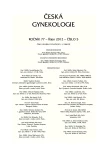Outcomes of anterior vaginal wall repair using polypropylene mesh
Authors:
Martin Huser
; M. Pastorčáková; I. Belkov; K. Sedláková
Authors‘ workplace:
Gynekologicko- porodnická klinika LF MU a FN, Brno, přednosta prof. MUDr. P. Ventruba, DrSc.
Published in:
Ceska Gynekol 2012; 77(5): 407-413
Overview
Introduction:
Pelvic organ prolapse (POP) is a major health concern especially in the elderly women. Anterior vaginal wall prolapse (AWP) represents the most common form of POP with reoperation rate 30–40% when primary treated by anterior colporrhaphy. Modern surgical techniques of POP repair uses polypropylene (PP) mesh implants to better support pelvic structures and lower the risk of recurrence. Aim of our study was to assess the safety and efficacy of anterior vaginal wall prolapse repair using PP mesh system NAZCA TC (Promedon). The kit consists of preformed PP mesh anchored to pelvic structures by two needle inserters via pre-pubic and trans-obturator route.
Methods:
From January 2010 to February 2011, 21 patients with stage III/IV AWP underwent transvaginal repair with implantation of PP mesh. The stage of POP measured according to POP-Q system, surgery length, blood loss and complications has been evaluated six month after the surgery. Surgery has been assessed as successful when POP stage 0/I o has been reached. In 42.9% of patients AWP repair was combined with other procedures: vaginal hysterectomy or posterior vaginal repair. (Statistical evaluation was done by Wilcoxon test.)
Results:
The average age of operated women was 62.4±9.4 years, average body mass index was 27.5±4.1 kg/m2, with overall parity of 2.2±1.4 children. The surgery time was 64.0±26.0 minutes with average blood loss of 185.0±17,0 ml. No serious per-operating complication has been recorded. The objective cure rate at 6 months was 90.5%. Statistically significant difference in the position of points Aa, Ba and C (p<0,05) has been observed. Difference in the position of other POP-Q points has not been statistically significant. Post operatively one case of small mesh erosion managed by observation only has been documented.
Conclusion:
Transvaginal repair of AWP with polypropylene mesh is an effective and safe technique in the hands of surgeon experienced in classical POP reconstruction techniques. For the assessment of long term efficacy the further follow-up of patients is necessary.
Key words:
pelvic organ prolapse, surgical treatment, polypropylene mesh, efficacy, complications.
Sources
1. Halaška, M., Voigt, R., Koleška, T., et al. Naše zkušenosti s přední plastikou podle Barnetta-Macku v léčbě inkontinence moči. Čes Gynek, 1988, 53 (6), p. 425–428.
2. Adedipe, TO., Vine, SJ. Immediate and perioperative outcomes of polypropylene mesh in pelvic floor repair in a predominantly obese population. Clin Experiment Obstet Gynec, 2010, 37 (4), p. 266–268.
3. Amid, PK., Lichtenstein, IL., Shulman, AG., Hakakha, M. Biomaterials for “tension-free” hernioplasties and principles of their applications. Minerva Chir, 1995, 50 (9), p. 821–826.
4. Bump, RC., Mattiasson, A., Bo, K., et al. The standardization of terminology of female pelvic organ prolapse and pelvic floor dysfunction. Am J Obstet Gyn, 1996, 175 (1), p. 10–17.
5. Dente, D., Paniccia, T., Petrone, D., et al. Early clinical experience with different mesh in correction of high-degree cystocele. Urologia, 2009, 76 (4), p. 247–251.
6. Eboue, C., Marcus-Braun, N., von Theobald, P. Cystocele repair by transobturator four arms mesh: monocentric experience of first 123 patients. Inter Urogynec J, 2010, 21 (1), p. 85–93.
7. Elin, G., Ska, JM., Setřes, X. [Transobturator subvesical mesh. Tolerance and short-term results of a 103 case continuous series]. Gynec Obstet Fertil, 2003, 31 (1), p. 14–19.
8. El Harrech, Y., Amur, A., Janane, A., et al. [Three years results of transvaginal cystocele repair with polypropylene mesh using a tension-free technique]. Actas Urol espanol, 2010, 34 (1), p. 82–87.
9. Goldman, HB., Fitzgerald, MP. Transvaginal mesh for cystocele repair. J Urol, 2010, 183 (2), p. 430–432.
10. Halaska, M., Sottner, O., Maxova, K., et al. [Prolene mesh comparing with sacrospinal fixation in the treatment of genital prolapse in women. Prospective multicentre randomized study]. Ces Gynek, 2010, 75 (2), p. 126–132.
11. Hiltunen, R., Nieminen, K., Takala, T., et al. Low-weight polypropylene mesh for anterior vaginal wall prolapse: a randomized controlled trial. Obstet Gynec, 2007, 110, p. 455–462.
12. Chmel, R., Vlk, R., Rob, L., Horcicka, L. [The Barnett-Macku method of anterior colporrhaphy in the prevention and treatment of urinary stress incontinence in women with cystocele]. Ces Cynek, 2003, 68 (1), p. 17–21.
13. Letouzey, V., Deffieux, X., Gervaise, A., et al.Trans-vaginal cystocele repair using a tension-free polypropylene mesh: more than 5 years of follow-up. Eur J Obstet Gynec Reprod Biol, 2010, 151 (1), p. 101–105.
14. Maher, C., Baessler, K. Surgical management of anterior vaginal wall prolapse: an evidencebased literature review. Inter Urogynec J Pelvic Floor Dysfunct, 2006,17 (2), p. 195–201.
15. Nguyen, JN., Burchette, RJ. Outcome after anterior vaginal prolapse repair: a randomized controlled trial. Obstet Gynec, 2008, 111 (4), p. 891–898.
16. Svabik, K., Martan, A., Masata, J., et al. Ultrasound appearances after mesh implantation-evidence of mesh contraction or folding? Inter Urogynec J, 2011,22 (5), p. 529–533.
17. Urdzik, P., Galad, J., Ostro, A. [Risk of the prolapse “de novo” in primary unaffected compartment by using the syntethic mesh in the surgery treatment of the pelvic organe prolapse]. Ces Gynek, 2011, 76 (4), p. 321–326.
18. Weber, AM., Walter, MD., Piedmonte, MR., Ballard, LA. Anterior colporrhaphy: a randomized trial of three surgical techniques. Amer J Obstet Gynec, 2001, 185 (6), p. 1299–1304; discussion 1304–1296.
Labels
Paediatric gynaecology Gynaecology and obstetrics Reproduction medicineArticle was published in
Czech Gynaecology

2012 Issue 5
Most read in this issue
- Outcomes of anterior vaginal wall repair using polypropylene mesh
- HE4 a biomarker of ovarian cancer
- Intrauterine system (Mirena) and ectopic pregnancy – case report
- Prevalence of Chlamydia trachomatis infection in patients treated for infertility
